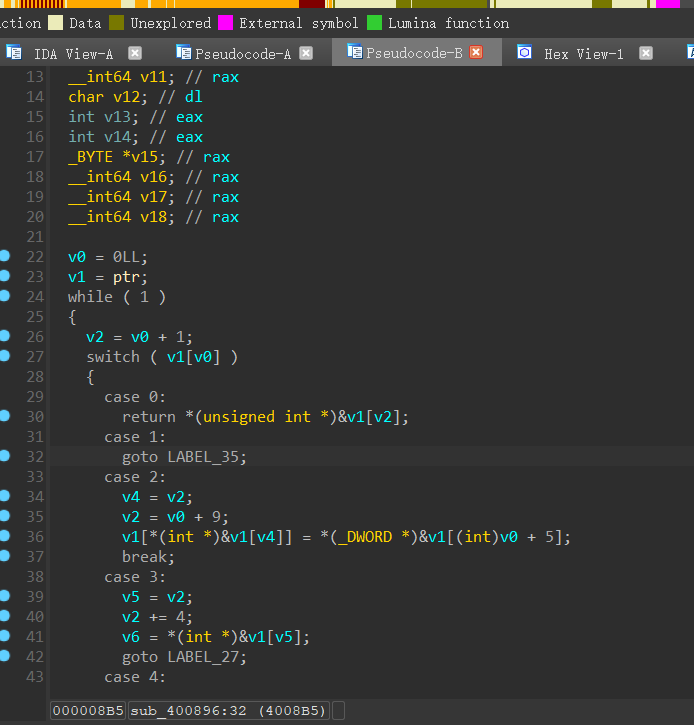1
2
3
4
5
6
7
8
9
10
11
12
13
14
15
16
17
18
19
20
21
22
23
24
25
26
27
28
29
30
31
32
33
34
35
36
37
38
39
40
41
42
43
44
45
46
47
48
49
50
51
52
53
54
55
56
57
58
59
60
61
62
63
64
65
66
67
68
69
70
71
72
73
74
75
76
77
78
79
80
81
82
83
84
85
86
87
88
89
90
91
92
93
94
95
96
97
98
99
100
101
102
103
104
105
106
107
108
109
110
111
112
113
114
115
116
117
118
119
120
121
122
123
124
125
126
127
128
129
130
131
132
133
134
135
136
137
138
139
140
141
142
143
144
145
146
147
148
149
150
151
152
153
154
155
156
157
158
159
160
161
162
163
164
165
166
167
168
169
170
171
172
173
174
175
176
177
178
179
180
181
182
183
184
185
186
187
188
189
190
191
192
193
194
195
196
197
198
199
200
201
202
203
204
205
206
207
208
209
210
211
212
213
214
215
216
217
218
219
220
221
222
223
224
225
226
227
228
229
230
231
232
233
234
235
236
237
238
239
240
241
242
243
244
245
246
247
248
249
250
|
#define _CRT_SECURE_NO_WARNINGS 1
#include <stdlib.h>
#include <stdio.h>
#include <windows.h>
long buf = 0;
void* ptr = 0;
#define _DWORD unsigned int
#define _BYTE unsigned char
#define __int64 unsigned int
DWORD globVar;
DWORD c;
__int64 vm()
{
__int64 currentInst;
_BYTE* base;
int nextInst;
__int64 v4;
__int64 v5;
__int64 v6;
__int64 v7;
__int64 v8;
__int64 v9;
int v10;
__int64 v11;
char v12;
int v13;
int v14;
_BYTE* v15;
__int64 v16;
__int64 v17;
__int64 v18;
unsigned int tmp;
currentInst = 0LL;
base = (_BYTE*)ptr;
while (1)
{
nextInst = currentInst + 1;
switch (base[currentInst])
{
case 0:
printf(exit);
return *(unsigned int*)&base[nextInst];
case 1:
tmp = *(_DWORD*)&base[nextInst];
printf(\t#1:0x%x GOTO 0x%x\n, currentInst, tmp);
goto LABEL_35;
case 2:
v4 = nextInst;
nextInst = currentInst + 9;
base[*(signed int*)&base[v4]] = *(_DWORD*)&base[(signed int)currentInst + 5];
printf(\t#2:0x%000x [0x%x] = 0x%x [0x00x]\n, currentInst, v4, *(_DWORD *)&base[(signed int)currentInst + 5], (signed int)currentInst + 5);
break;
case 3:
v5 = nextInst;
nextInst += 4;
v6 = *(signed int*)&base[v5];
printf(\t#3:0x%000x C (0x%x) = DB [0x%x] (0x%x) \n, currentInst, c, v6, base[v6]);
goto LABEL_27;
case 4:
v7 = nextInst;
nextInst += 4;
v8 = *(signed int*)&base[v7];
printf(\t#4:0x%000x [0x%x] = C (0x%x) \n, currentInst, v8, c);
goto LABEL_31;
case 5:
v9 = nextInst;
nextInst += 4;
v10 = (char)base[*(signed int*)&base[v9]];
printf(\t#5:0x%x G (0x%x) = [0x%x] (0x%x)\n, currentInst, globVar, *(signed int *)&base[v9], v10);
goto LABEL_21;
case 6:
v11 = nextInst;
v12 = globVar;
nextInst += 4;
v8 = *(signed int*)&base[v11];
printf(\t#6:0x%x [0x%x] (0x%x) = G (0x%x)\n, currentInst, v8, base[v8], globVar);
goto LABEL_9;
case 7:
printf(\t#7:0x%x \n, currentInst);
v13 = globVar;
goto LABEL_23;
case 8:
v14 = ~(globVar & c);
printf(\t#8:0x%x C = ~(storedG 0x%x & C 0x%x) RES = 0x%x \n, currentInst, globVar, c, v14);
goto LABEL_12;
case 0xA:
printf(\t#0xA:0x%x C = GETCHAR() \n, currentInst);
v14 = getchar();
goto LABEL_12;
case 0xB:
printf(\t#0xB: PUTCHAR(C) \n);
putchar(c);
break;
case 0xC:
v15 = &base[*(signed int*)&base[nextInst]];
printf(\t#0xC:0x%x IF [0x%x]-- (0x%x) GOTO 0x%x ----------- \n, currentInst, nextInst, *v15, *(_DWORD *)&base[nextInst + 4]);
if (*v15)
{
nextInst = *(_DWORD*)&base[nextInst + 4];
--* v15;
}
else
{
printf()))) endloopp\n);
nextInst += 8;
}
break;
case 0xD:
printf(\t#0xD:0x%x C++ (0x%x)\n, currentInst, c);
++c;
break;
case 0xE:
printf(\t#0xE:0x%x G++ (0x%x)\n, currentInst, globVar);
++globVar;
break;
case 0xF:
printf(\t#0xF:0x%x \n, currentInst);
v14 = globVar;
goto LABEL_12;
case 0x10:
printf(\t#0x10:0x%x G (0x%x) = C (0x%x) \n, currentInst, globVar, c);
v10 = c;
goto LABEL_21;
case 0x11:
v16 = nextInst;
nextInst += 4;
v13 = *(_DWORD*)&base[v16];
printf(\t#0x11:0x%x C (0x%x) += DD (0x%x) \n, currentInst, c, v13);
LABEL_23:
c += v13;
break;
case 0x12:
printf(\t#0x12:0x%x C = G (0x%x)\n, currentInst, globVar);
v6 = globVar;
goto LABEL_27;
case 0x13:
printf(\t#0x13:0x%x C = [C] (0x%x)\n, currentInst, c);
v6 = c;
LABEL_27:
v14 = (char)base[v6];
goto LABEL_12;
case 0x14:
printf(\t#0x14:0x%x \n, currentInst);
v17 = nextInst;
nextInst += 4;
v14 = *(_DWORD*)&base[v17];
goto LABEL_12;
case 0x15:
v18 = nextInst;
nextInst += 4;
v10 = *(_DWORD*)&base[v18];
printf(\t#0x15:0x%000x G (0x%x) = DD [0x%x] (0x%x) \n, currentInst, globVar, v18, v10);
LABEL_21:
globVar = v10;
break;
case 0x16:
printf(\t#0x16:0x%x [G(0x%x)] = C (0x%x)\n, currentInst, globVar, c);
v8 = globVar;
LABEL_31:
v12 = c;
LABEL_9:
base[v8] = v12;
break;
case 0x17:
printf(\t#0x17:0x%x C (0x%x) -= G (0x%x) \n, currentInst, c, globVar);
v14 = c - globVar;
LABEL_12:
c = v14;
break;
case 0x18:
printf(\t#18:0x%x if C (%0x %d) goto 0x%04x <<<<<<<<<<<<<<< \n, currentInst, c, c, *(_DWORD *)&base[nextInst]);
if (c) {
LABEL_35:
nextInst = *(_DWORD*)&base[nextInst];
}
else
nextInst = currentInst + 5;
break;
default:
break;
}
if (nextInst >= buf)
return 0LL;
currentInst = nextInst;
}
}
int main()
{
FILE* v3;
const char* v4;
FILE* v5;
size_t v6;
void* v8;
v3 = fopen(p.bin, rb);
v4 = err 0;
if (!v3)
goto LABEL_4;
v5 = v3;
fseek(v3, 0LL, 2);
buf = ftell(v5);
fseek(v5, 0LL, 0);
v6 = buf;
if (buf <= 0)
{
v4 = err 1;
LABEL_4:
puts(v4);
return 0xFFFFFFFFLL;
}
v8 = malloc(buf);
ptr = v8;
v4 = err 3;
if (!v8)
goto LABEL_4;
v4 = err 4;
if (buf != fread(v8, 1uLL, v6, v5))
goto LABEL_4;
fclose(v5);
v4 = err 5;
if ((unsigned int)vm())
goto LABEL_4;
free(ptr);
return 0LL;
}
|
 - 经过简单的分析知道,首先程序会打开“p.bin”的文件然后在内存中分配一个和文件大小一样大的空间。并把分配 好的内存的地址存放到v5,再经过fread()函数读取文件中的内容存放到内存中
- 经过简单的分析知道,首先程序会打开“p.bin”的文件然后在内存中分配一个和文件大小一样大的空间。并把分配 好的内存的地址存放到v5,再经过fread()函数读取文件中的内容存放到内存中
 - 看到这里对于初学者来说可能比较吃力,毕竟笔者也是初学者所以刚开始看的时候着什么玩意啊哈哈哈
- 看到这里对于初学者来说可能比较吃力,毕竟笔者也是初学者所以刚开始看的时候着什么玩意啊哈哈哈







